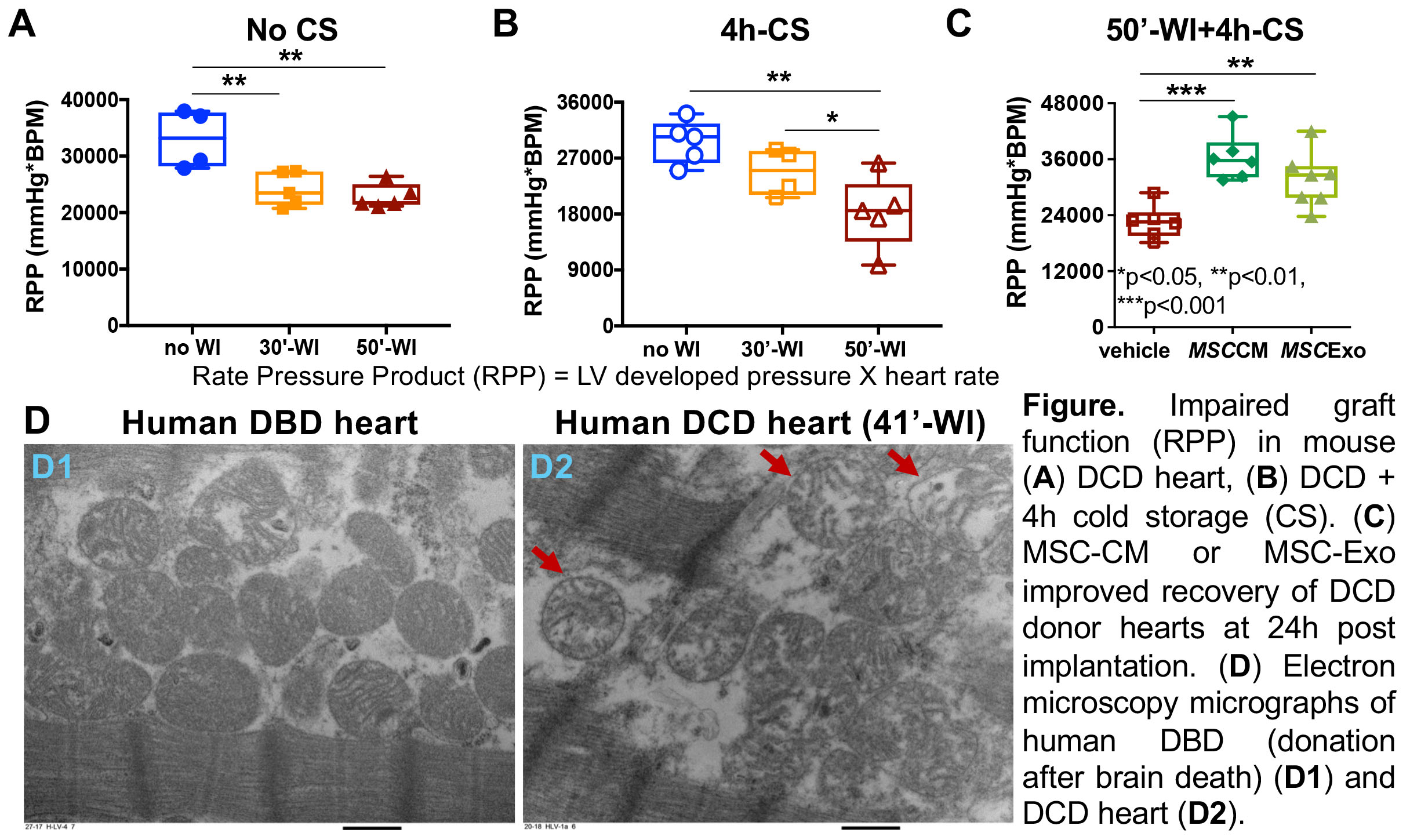Final ID: MDP316
Towards transplantation of hearts from donation after circulatory death - stem cell derived therapy for ameliorating donor organ damage
Abstract Body (Do not enter title and authors here): The use of heart transplantation (HTx), a key life-saving therapy for end-stage heart failure, is limited by the shortage of acceptable donor hearts. Although donation after circulatory death (DCD) offers a potentially promising resource for clinical transplantation, its adoption for HTx is concerned by warm ischemic damage during the death process. Mesenchymal stem cell (MSC)-derived paracrine action has been proved to mediate cardioprotection. Based on our previous study showing that MSC conditioned media (MSC CM) and MSC-exosomes (MSC Exo) confer improved donor heart preservation during cold ischemic storage, we aimed to test the effect of MSC CM and MSC Exo on ex vivo recovery of ischemia-damaged myocardium and on promoting the implanted DCD heart function using an in vivo murine heterotopic heart transplantation model.
Methods: Donor hearts from adult male C57BL/6 mice with 0, 30’ or 50’ in vivo warm ischemia (WI) were divided into (n=5-7/group): 1) no WI; 2) 30’-WI; 3) 50’-WI; 4) no WI+4h cold storage at 0-4°C (no WI+CS); 5) 30’-WI+CS; 6) 50’-WI+CS; 7) 50’-WI+CS+vehicle; 8) 50’-WI+CS+MSC CM; and 9) 50’-WI+CS+MSC Exo. The CM and Exo were obtained from cultivation of human bone marrow-MSCs in serum-free media for 72h and was added into preservation solution. Donor hearts were implanted into C57BL/6 male recipients using cervical heterotopic heart transplantation. At 24h post-surgery, left ventricular (LV) function was detected in transplanted hearts. Abdominal artery pressure was measured in recipients to validate technical reproducibility of the HTx model. Mitochondrial structure was detected by electron microscopy on the fixed human LV (hDCD & hDBD).
Results: WI significantly impaired LV function in transplanted DCD hearts vs. no-WI (Fig. A, B). Intriguingly, markedly improved graft function was observed in MSC CM- or Exo-treated DCD hearts vs. vehicle (Fig. C). Short and disrupted cristae in mitochondria were noticed in hDCD vs. hDBD (Fig. D).
Conclusions: Our results represent the initial evidence that MSC secretome (CM & Exo) mediates ex vivo cardiac repair in DCD hearts and validate an approach on MSC derived therapy to rescue marginal DCD donor hearts and improve post-transplant graft function.
Methods: Donor hearts from adult male C57BL/6 mice with 0, 30’ or 50’ in vivo warm ischemia (WI) were divided into (n=5-7/group): 1) no WI; 2) 30’-WI; 3) 50’-WI; 4) no WI+4h cold storage at 0-4°C (no WI+CS); 5) 30’-WI+CS; 6) 50’-WI+CS; 7) 50’-WI+CS+vehicle; 8) 50’-WI+CS+MSC CM; and 9) 50’-WI+CS+MSC Exo. The CM and Exo were obtained from cultivation of human bone marrow-MSCs in serum-free media for 72h and was added into preservation solution. Donor hearts were implanted into C57BL/6 male recipients using cervical heterotopic heart transplantation. At 24h post-surgery, left ventricular (LV) function was detected in transplanted hearts. Abdominal artery pressure was measured in recipients to validate technical reproducibility of the HTx model. Mitochondrial structure was detected by electron microscopy on the fixed human LV (hDCD & hDBD).
Results: WI significantly impaired LV function in transplanted DCD hearts vs. no-WI (Fig. A, B). Intriguingly, markedly improved graft function was observed in MSC CM- or Exo-treated DCD hearts vs. vehicle (Fig. C). Short and disrupted cristae in mitochondria were noticed in hDCD vs. hDBD (Fig. D).
Conclusions: Our results represent the initial evidence that MSC secretome (CM & Exo) mediates ex vivo cardiac repair in DCD hearts and validate an approach on MSC derived therapy to rescue marginal DCD donor hearts and improve post-transplant graft function.
More abstracts on this topic:
Cardiac protection of hiPSC-CMs loaded chitosan cardiac patch in myocardial infarcted swine
Zheng Zilong, Li Yichen, Tang Weijie, Chen Wangping, Yang Jinfu, Fan Chengming
Application of PLGA-PEG-PLGA Thermosensitive Hydrogel Loaded with Human Induced Pluripotent Stem Cell-Derived Cardiomyocytes and Ginsenoside Rb3 in the Treatment of Acute Myocardial InfarctionXiang Kun, Zheng Zilong, Li Yichen, Tang Weijie, Chen Wangping, Yang Jinfu, Fan Chengming

